Airfix 1/48 Hurricane I (trop)
Following the success of the Battle of Britain, the RAF could allow the Hurricane to be sent to other theaters. The defense of Malta had been so important that a squadron had been diverted to that island at the height of the Battle of Britain. Now, in the fall of 1940 and early 1941, the Hurricane I, which was outclassed by the new “Friedrich” version of the Bf-109 could be sent to Egypt, where it outclassed the Italian C.200 “Saetta”, the most modern Italian fighters, and was clearly superior to the C.R.42 biplane. By March, when the British were preparing to move into Greece to bolster that country's fight with the Italians, the Gloster Gladiators in the squadrons sent had all been replaced by Hurricanes.
After diverting squadrons to Greece, the RAF was short of fighters in Egypt. The Fleet Air Arm squadrons 805 and 806 now found themselves without a carrier from which to operate with the near destruction of HMS Illustrious and that ship's subsequent departure via the Suez Canal for major repairs in the United States. 805 Squadron was issued the F4F-3 Wildcats that the Greek Air Force had ordered, which were still in Egypt at the time Greece fell, while 806 Squadron was issued Hurricane Is, with both squadrons operating as the Naval Fighter Wing North Africa. They took part in the fighting around Tobruk in the summer of 1941, and other fighting in North Africa up to January 1942, when the RAF was able to send sufficient squadrons to what was now known as the Desert Air Force that the FAA squadrons were no longer needed. Both were repatriated to the UK where they returned to their naval roles.
To modify the kit for the tropical version, a modeler only has to assemble the two halves of the Vokes filter and glue that to the lower fuselage nose part, then take a razor saw and cut out the central part of the lower wing forward of the landing gear, following the two panel lines to either side of the carb intake. I then glued the foward section to the lower wing so I could work the joint from inside and outside to get it right.
The Hurricane I (tropical) first arrived in the Middle East still painted in Dark Earth/Dark Green/Sky. By the summer of 1941, many of the surviving aircraft were having their Dark Green areas repainted in either Middle Stone or Light Earth, to adapt them better to the desert environment. Also, many Hurricanes were painted with an “Italian” camouflage on the wing leading edge and nose, to confuse their opponents when approaching. This has long been though to have been a color such as Middle Stone or Light Earth, and might have been on the DE/DG/Sky painted aircraft. However, recent research has shown that those Hurricanes that received the “desert” camouflage repaint used aluminum lacquer on the leading edge and nose, which “glinted” in the bright desert sun and contributed to difficulty in initial identification when entering combat, a few moments that could make the difference between success and failure.
In making a model of an airplane repainted in the field, I painted the lower surfaces Sky, and the upper surfaces Tamiya “Flat Earth” - a good approximation of faded Dark Earth - and “light earth, which was done with a mixture of Tamiya “Flat Earth” and “Desert Yellow.” This was all done freehand to approximate an “in the field” repaint. Photos clearly show that the Dark Green (or perhaps Dark Earth) splotches and “spaghetti” were brush-painted. I brush-painted both the aluminum and the squiggles, using Tamiya RAF Dark Green. I used decals from several old Aeromaster decal sheets for the national insignia, the serial number and the “Royal Navy” marking.
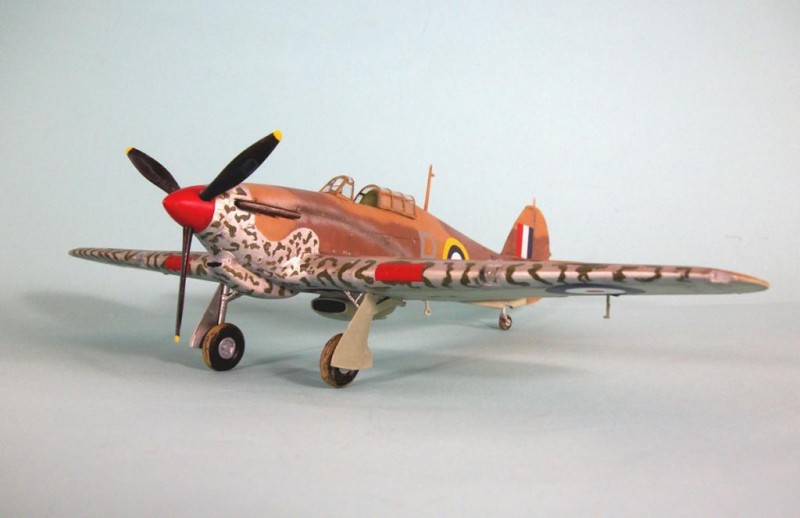
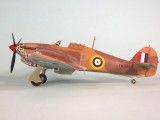
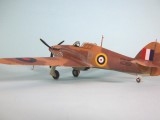
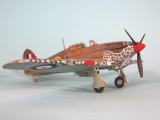
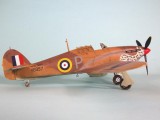


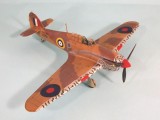


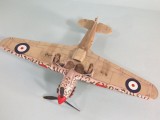
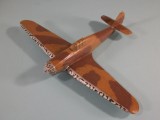
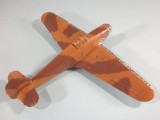
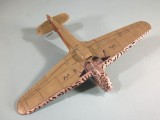


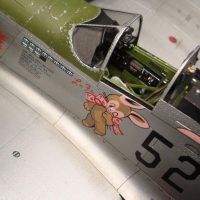

Tom: Favorite Hurri scheme of mine. This is a revelation to me, as I "always" (cough cough) THOUGHT the LEs were some kind of tan with green squiggles. That'll learn me!
Thanks for updating my Hurri scheme knowledge, 'cause I'm gonna do one of these. The RN is a bonus, and I appreciate your doing the research on this for me. Double obscure stuff.
Learned something today! Good gen!
I'm thinking I need a couple more Airfix Hurricanes...
There's no such thing as too many Airfix Hurri kits. I just wish they'd get busy and produce some more!
Very interesting historical note to accompany the unusual scheme! Well executed as always.
Smashing !
Good looking scheme. At first glance I thought it was a 'what-if' Tiger Meet' livery!
Hi Tom,
Great build once again. The South African Air force started pushing the Italians out of Africa in 1940 - 1941, fighting from Kenya all the way to Somalia, they were equipped with a few Hurricain's at that time, but mostly flew Gladiators the Hawker Hartbeest the JU 86 etc, there is a great web page where you can see a SAAF Hurricain also painted in a similar paint scheme as you have depicted on your build, the web page http://saafww2photographs.yolasite.com/east-africa-1940-1941.php thanks for sharing Tom, I always enjoy the history lesson.
Tom thanks for the great history lesson! You have inspired me to buy this kit today! Beautiful scheme. As Mark has pointed out the SAAF used various Hurricane fighters in North Africa. The nicest being the tank buster Hurricane variant. I hope Airfix release it soon! Again well done!
Im like and nice build Hurrican .
P.k
nice interesting history never knew this
There's virtually nothing in the historical record about the Naval Fighter Wing North Africa. Today I was looking through Osprey's "Fleet Air Arm in World War II" and discovered there were three squadrons (a "wing"), 805 with the Martlet III and 806 and 803 with the Hurricane I. I have been doing some detailed internet searches, but you now know as much as 3 hours will give you (and the big new item was in a book at the LHS).
Amazing timing - an e-mail from a European friend reveals that the Naval Fighter Wing took part in the fighting in Syria against the Vichy French in 1941, and they were the primary British fighter unit. 803 was sent to the NFW after Formidable was damaged. Makes sense - they had these FAA pilots with lots of experience and no carriers or airplanes, so stick them in RAF fighters and what else is available (the Martlets) and you have an experienced fighter unit.